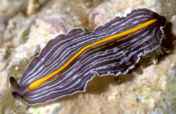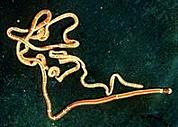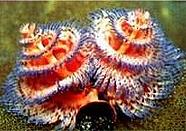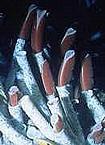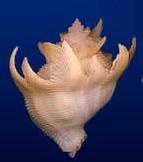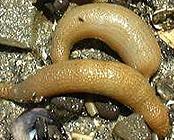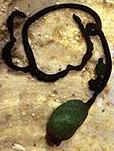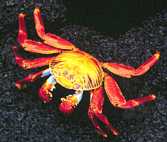Zoology 250 Phylogenetic Trees (2007)
========================== Platyhelminthes (flatworms, tapeworms,etc.
|
| ===(branch uncertain)== 'pseudoceolomates' (nematodes, rotifers,etc.)
| |
===P===| | ================ Nemertea (ribbon worms)
| | | |
| =1=| | ======= Mollusca (snails, clams, squids, etc.)
| | | ==3==|
| ===C===| | ======= Sipuncula (peanut worms)$
| | |
<<=B=| B- BILATERIA | | == Annelida (segmented worms)
| | | =6=|
| P- PROTOSTOMIA =2==| =5=| == Pogonophora (beard worms, vent worms)$$
| S? | | |
| C- COELOMATE =4==| ===== Echiura (proboscis worms)
| PROTOSTOMES S? |
| ==7===== Panarthropoda (velvet worms, insects, spiders, crabs, etc.)
| S? ORIGIN OF
| SEGMENTATION?
================================= Deuterostomia (echinoderms, chordates, etc.)
$ Boore & Staton. 2002. Mol. Biol. Evol. 19:127-137 suggest mtDNA gene order of Sipuncula may be more similar to annelids than to molluscs.
$$ now considered to be an order of polychaete annelids (in the Canipalpata)!
Back to Zool 250 tree for animal phyla
TRAITS SUPPORTING EACH CLADE(** plesiomorphic- a primitive state, not unique to clade):
P= PROTOSTOMIA:
a) spiral, determinate cleavage
b) mesoderm from single (mesentoblast) cell
c) fate of first germ cell set at 5th cleavage
d) mouth (and sometimes anus) from blastopore
e) sheets of sub-epidermal muscles
f) multiciliated cells
1:
a) anus present
b) circumpharyngeal ganglia
c) paired gonoducts
d) circular muscle layer lies outside longitudinal muscle layer
C= COELOMATE PROTOSTOMES:
a) coelom via schizocoely
b) trochophore-like larva with apical cilia
c) larvae swim with compound cilia
2:
a) larvae possess prototrochal cilia
b) entomesoblast cell yields paired coeloms (mesoderm)
c) paired ventral nerve bundles
d) dorsal contractile vessel or heart
e) gonads lie in coeloms
f) heart lies in coelomic pericardium
g) metanephridial funnel opens in coelomic sac
h) dorsal heart pumps anteriorly
|
3:
a) "molluscan cross" at 64-cell stage
b) scraping buccal organ *
c) muscular creeping foot *
* traits b and c occur only in Sipuncula larvae
4= ARTICULATA:
a) pre-oral prostomium/acron
b) anus-bearing pygidium/telson
c) paired: ventral nerve cords with segmental ganglia
(only in late larva & postlarva of Echiura),
coelomic cavities, metanephrida, & gonads
d) engrailed expression at posterior segm. margins
5:
a) "annelid cross" in 64-cell embryo
b) protrusible epidermal, chitinous setae in setal sacs
6:
a) fully segmented coelom and body wall muscles
(only in opisthoma of pogonophorans)
7= PANARTHROPODA:
a) elongate body of multiple similar segments**
b) ventro-lateral legs (lobopods) with hooked tips
c) must molt to grow
d) similar chemical makeup of cuticle
e) ectodermal cilia lost
f) extensive hemocoel ('open' circulatory system), coeloms reduced
g) heart with openings to hemocoel (ostia)
h) panarthropodan sensilla
i) superficial cleavage, no trochophore-like larva
|
Return to Zool 250 Home Page or try your skill at the Invertebrate Diversity Quiz.
Copyright (c) 2007 by A. Richard Palmer. All rights reserved.
(revised Jan. 7, 2007)
